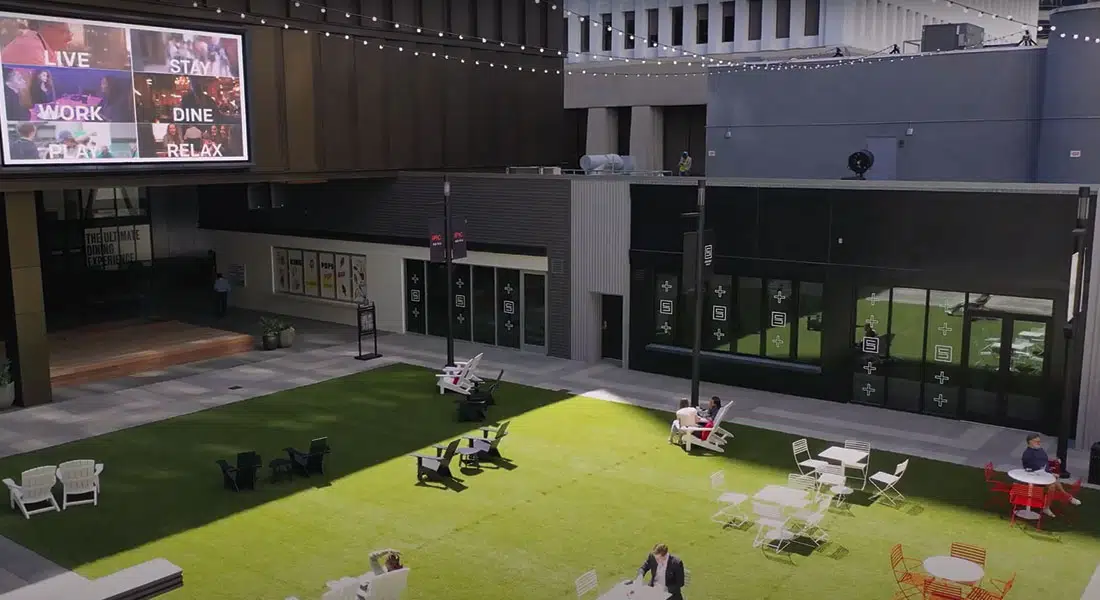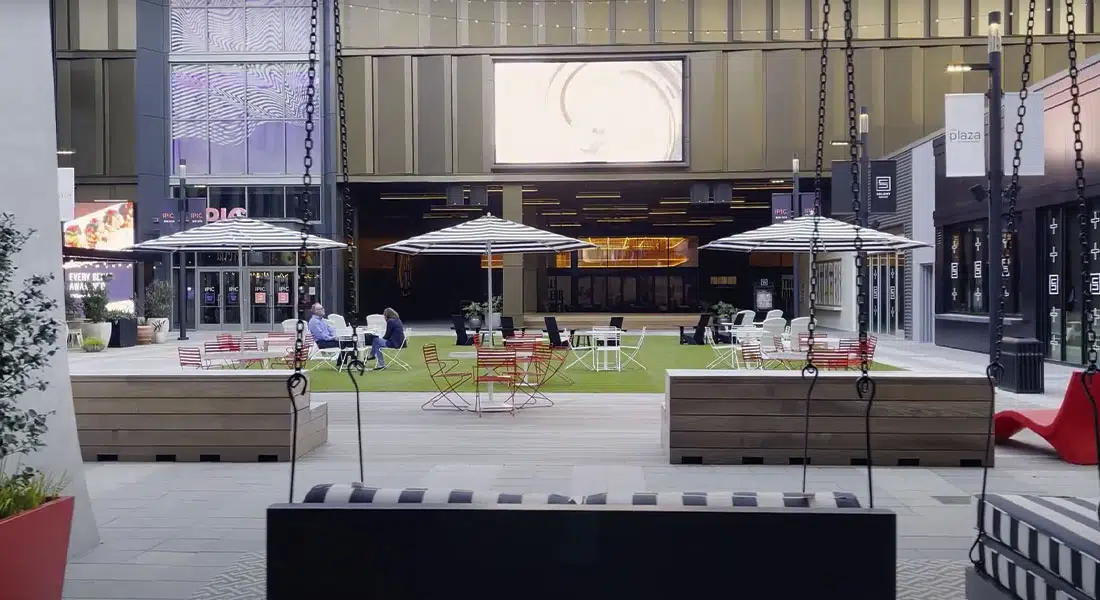A Place to Be
Both landscape and architectural design used to be more about buildings – skylines, construction, metropolitan structuring, a tangible legacy in concrete and steel. In the current and coming decade it is humanely evolving into an art form centered around a single goal: People and their personal experiences.
“Experience” is (and has been) a trending buzzword, but the result of designing for experience translates into every level of engagement from connections, community, and individual well-being to consumer behaviors that directly affect brand awareness and economic profit.
With “experiential design” already the talk of the industry for the last decade or more, retail and outdoor spaces are again experiencing an evolution or escalation of purpose. This is fueled in part by changing social behaviors in a year of pandemic culture-shifting, and in part by the success of “experience-driven” projects executed in recent years, measuring their positive impact on usage, engagement, and the surrounding commercial entities.
One of our design Principals Kevin McCarthy, speaks to this next-level development with prominence, poetics, and passion for people and place. No longer just building on the trend of experiential design, SITE solutions is creating personal experiences that McCarthy describes as “deep and meaningful” – designing locales that are transformational to those who occupy and interact within them and for the surrounding communities, influencing consumer behaviors and the culture as a whole.
McCarthy says of these goal-oriented projects, “The design informs and contributes to every new site's sense of place and quality of sui generis (uniqueness and singularity), apt for today’s time of blended project types, delivery mechanisms, vertically integrated mixed use, public /private partnerships and landscapes on/in/over buildings.” Altruistic in nature, this "people first” philosophy is a full circle business model as participation brings revenue, and thriving communities drive both population and economy.
Serendipitous Encounters
Approaching the literal drawing board to create a draw that combats both loneliness and the habit of home and comfort zones. “Loneliness can even be compounded in real life with people tripping over their screens,” as McCarthy says, “You have to give people a reason to step out of their house, to see and be seen – and for this you have to create not just places to go, but places to be.”
This means infusing “drive by urbanism” with a “desire for walkability,” and a motivation, invitation, and stand-apart enticement to walk into a main-street environment. McCarthy references the “Third Place.” It’s not work (defined as employment) and not home (defined as living space), it’s hard to put a finger on the definition or role it plays psychologically or from a need-based perspective for the individual, but it’s as important as the other two, as McCarthy describes, “An external, shared place to feel welcome and socially energized.”

SITE solutions is the driving force behind several built and upcoming regional venue projects that aim to address this issue (of defining the Third Space) and fulfill this need, from ground-up new developments to retrofits (repositioning projects 15 to 20 years past their initial design, able to offer “good bones,” but may not be fully cognizant nor updated for today’s social and experiential needs). Working together with North American Properties – who trademarked the phrase ExperienceMakers™ is providing great alignment with SITE solutions’ ideology – SITE solutions partners in Landscape Architectural Services “focusing on design that enhances how properties are enjoyed.”
North American Properties describes their architectural and planning process as “specializing in complex mixed-use and innovative developments, bringing together property types to create community space – assembling all the elements with intent of giving back to the community.” In a single sound bite, they explain that their properties “succeed out of community engagement and investment return follows.”
Atlanta Managing Partner Tim Perry states, “We use hospitality to engage community but start by looking at the physical (built) environment, using that to create places to gather, embodying a brand specific to community, and encouraging interface between tenant and guest (who might be a customer), between guests to each other (who might have impromptu connections), and between guests and the community itself (enhancing guest experience which creates more foot traffic and better sales and investments for owners).”
One such example of this collaboration is Colony Square and its recently opened Politan Row Food Hall. The newly designed space covers 42,000 square feet spanning interior and exterior use, separated by an opening glass partition and a digital interface enabling contactless ordering and pick-up in a post-pandemic culture. A standard element always incorporated by SITE solutions is the intentional mix of permanent and movable furnishings that can be rearranged for programming flexibility, as well as creation of personal space, ownership, and comfort.
Other similar projects at various stages of completion include but are not limited to Newport on the Levee, Birkdale Village, Avalon, and Avenue East Cobb, each developed with an intentionality to become what North American and SITE solutions both refer to as a “community owned asset.”
Conscious Design & Unanticipated Experiences
For SITE solutions, almost more important than what is produced, is the focus on approaching design with a “why” behind every decision and the overall business model, which McCarthy notes is an effort to make “unanticipated experiences come alive.” This is accomplished through an artful methodology of scaling exterior rooms to be comfortable for the right quantity of people and creating “animation along the edges.”
“We spend a lot of time along the edges,” McCarthy muses. “We think of the architectural frame as the skins of our space – the exterior that marks the spot where something happens. If you can really animate the edges, if you can create and draw seating along the fringe but program the center space where it comes alive with performances or things to do for different user groups – people, characters on a stage – that’s what makes the overall project come alive.
McCarthy also specifies, “To make this worth their while patrons got to get something back that they can’t get anywhere else” which goes for both the consumer and the property owner. “When you can program the places and keep the main focus active and activated, the formula drives traffic and therefore sales. This value proposition allows rents to rise (or be raised) and adds revenue. We create places for people (guests, tenants, and residents) and in return their very presence creates higher value and therefore higher revenue.” It’s a synergistic cycle.
Being conscious of what spaces need to be beyond just personal use but in environmental responsibility, economic diversity, and marketplace demands. “These places,” says McCarthy with an air of accountability, “have a conscience.”
Redefining Main Street
This work and aim make the most sense when seen in action and in use by the general public – people out in numbers, retail-accessible, engaging as consumers, observers, connecting with or contributing to other community members, active participants in urban settings where they wouldn’t have been before. Redefining Main Street in a way that brings the familiarity and connection of yesteryear’s downtown plazas, with the reinvented opportunities, observations (technology, media, digital communication), and interactive access points for a new millennium.

“People don’t yet realize what they’re missing because of how the world has changed – they need to connect. They feel what’s missing but not why it’s missing nor how to get it back,” McCarthy knows, adding, “SITE solutions designs something special for them to experience and it in return drives income. Even through these recent challenges our clients are learning that everything will work in the end.”
McCarthy enthusiastically celebrates where urban planning and design are going and that SITE solutions is able to lead and influence the evolution. “Both the market and popular press have finally caught up to what we landscape architects do. The environment demands our attention.
And who would have thought that contributing to public health would re-emerge as a defining characteristic of our profession and our designed outdoor places? It is a beautiful day.”
